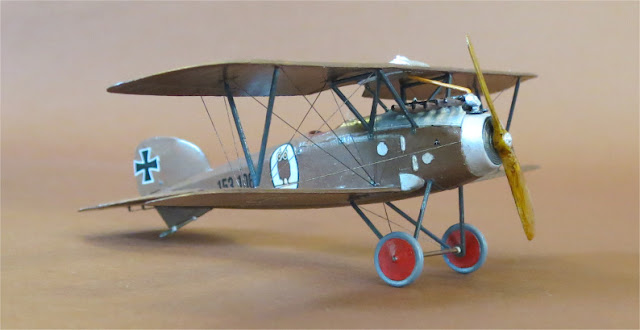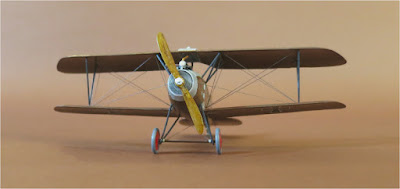If it looks like an Albatros, sports black crosses like an Albatros, and flies like an Albatros, then it probably... Actually, this isn't, exactly. And in certain respects, it didn't fly like an Albatros. For one thing, it didn't occasionally shed its lower wings. For another, although it did carry the black crosses of the aircraft of the Central Powers of World War One, it wasn't German. This is the Albatros fighter licence-built by the Austro-Hungarian company Oeffag.
The background to the production of this type in Austria is that there was a serious lack of capable fighter aircraft in the armed forces of the Dual Monarchy. Much smaller anyway than the German air arm, Austrian aviation had only managed to equip itself with a series of mediocre fighter types which were sometimes much more dangerous for their own pilots than the enemy's. At the time, the famous German Albatros D.I and II, the D.III with its distinctive V struts, and later the shark-like D.V, were matching all the various Allied aircraft on the Western Front. The Austrians gained a licence to manufacture first the D.II and then the D.III, on which Oeffag based a series of increasingly powerful variants, differing mainly in the power of their engines. One of the few visible differences between the German Albatroses and the Austrian ones was the replacement of the Mercedes engine with the home-grown Austro-Daimler.
Another difference, invisible but possibly more important, derived from the excellent wood working skills of the company. They addressed the structural problems of the Albatros's wings and strengthened the machine in every weak area. It was a much better built aeroplane.
You may notice something odd about the nose of this particular plane, and if you're familiar with the shape of the original Albatros, you will wonder what has happened to the propeller spinner. This was a curved cone which fronted the streamlined shape of the whole machine. The flat plate behind the propeller obviously isn't streamlined; but surprisingly the plane flew better without the spinner, if not a tad faster. What had happened was that the Austrian pilots suffered a number of incidents in which the spinners disintegrated or detached themselves in flight. Later, Oeffag rounded the nose to give the type an outline quite distinct from the German variant.
This particular aircraft, an early example of the 153 series, was one of a number flown by Lt. Franz Gräser while flying with Flik 61/J in March 1918. He gained between 18 and 20 victories. The owl was his personal insignia; the brown finish was carried by this squadron's aircraft possibly for experimental night flying. The Oeffag Albatroses were delivered mostly unpainted (despite official requests to the contrary), which led to a wild variety of finishes amongst the Austro-Hungarian squadrons.
This 1:72 scale kit was one of five Roden produced some years ago, of Oeffag Albatros variants. It's a very simple kit but the scale does require you to pay attention and take care. The rigging is reasonably straightforward, it's simply the scale as I say which makes it time consuming, as I took a lot of time with a 0.3mm drill in a pin vice. As far as modifications are concerned, the cockpit was open enough to lead me to add seat belts, guns (well, the butts at least are very visible) and some crude instrument dials. I also added a windscreen. If you squint hard, you can see some of these in the picture above.
I'm very pleased with this one. Maybe I did take a while, for such a small model, but the overall effect is what I wanted. I found a decal set by Printscale which included markings for Gräser's plane, for me it's an attractive scheme and it should go well with the grouping of some of these Austro-Hungarian Albatroses which I'm planning. But don't hold your breath!




Hi Mark another masterpiece I like the history
ReplyDeleteThank you very much; yes indeed, it's the history which drew me to these Austrian versions of the famous Albatros.
Delete